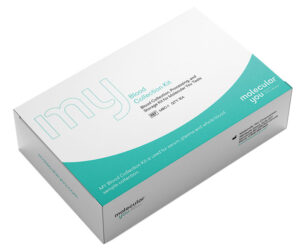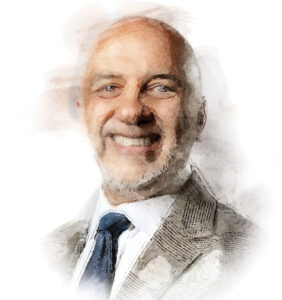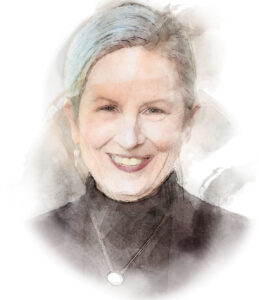
Digital health tools and technologies were thrust into the spotlight during the pandemic and were able to help many people get much needed medical advice and treatment when few other options were available. However, whether this boost to the industry will remain after a year of relative normalcy and a reduction in the COVID-19 threat is less clear.

chief technology officer
University of Pittsburgh Medical Center (UPMC)
“We’re just scratching the surface,” University of Pittsburgh Medical Center (UPMC) chief technology officer Christian Carmody told Inside Precision Medicine. “I think COVID helped change that mindset of where, when, and how we get our health care, when we were forced to stay away and stay in isolation, and I think that’s stuck. Things like telemedicine and telehealth visits really enabled us to continue delivering care in that very difficult time. Consumers were open to receiving care that way and engaging with clinicians much more quickly, and more conveniently than ever before.”
Technology has the potential to bring precision medicine to more people and to really democratize the patient journey, but there are also significant challenges that need to be addressed before digital health can really become mainstream.
Regulation of digital health technology in the U.S. still lags behind innovation, although the FDA and the Office of the National Coordinator for Health Information Technology (ONC) are working to improve and update official standards and regulations.
Improved regulatory standards should also help improve uptake and reimbursement of these tools by payers increasingly looking to implement preventative “value-based” medicine, as championed by the Affordable Care Act.

“In the next five years, the Centers for Medicare & Medicaid Services (CMS) wants providers that do Medicare to go from about 6% value-based care to 40%,” explained Jim Kean, CEO of digital health company Molecular You, which has developed an affordable metabolic and proteomic screening test that can alert individuals to health problems such as early-stage cancer.
This is an admirable goal and there is no doubt digital healthcare innovation can go some way to making it happen, but whether challenges such as limited system interoperability; payer, investor, and regulator caution; and healthcare provider education and uptake can be overcome in time remains to be seen.
The promise of digital health
“The promise of digital health is the ability to rethink many aspects of healthcare delivery,” said Ariel Stern, an associate professor in the Technology and Operations Management Unit at Harvard Business School, who has a research focus on digital health.
“From a health equity perspective, instead of forcing patients to come into a physical building and location, we’re able to meet them where and when it’s convenient for them,” explained Carmody.
Uses of digital tools and technology in healthcare are broad and continually expanding, ranging from making time for clinicians and nurses by automating admin tasks to monitoring patients in their homes, as well as predicting and improving outcomes for different patient groups.
UPMC is a large health care provider and insurer in the state of Pennsylvania, operating 40 hospitals and more than 700 doctors’ offices and outpatient centers. During the last decade, Carmody and team have developed several different digital tools and models to help improve patient care at UPMC.
These include a predictive model that can assess a patient’s risk of undergoing a given surgical procedure in advance and another model that can predict the probability that a patient will be readmitted to the hospital in 7 or 30 days.
“This model changes how we intervene with that patient in terms of sending them home with the care managers. They will take different steps to help keep that person on the path to wellness and recovery and to not have them come back into the hospital,” explained Carmody.
“We’ve seen tremendous improvements across all of our hospitals because of that data, because of those insights that our very brilliant physicians and researchers and data scientists have developed to identify those situations.”

Canadian biotech company Molecular You is providing a combination of lab testing and digital health tools. Customers can have an inexpensive blood test that assesses 250 proteomic and metabolomic biomarkers that are linked to disease risk. They are then provided with risk scores and advice via one or more telehealth appointments and are given access to relevant health and fitness information.
“One of our longtime subscribers has had a test every year. On her most recent test, she had a risk profile of stage one pancreatic cancer… We caught it, it was stage one, and she had three little lesions so she could have laparoscopic surgery. After the surgery, we reran the tests and the biomarkers have returned to normal levels,” said Kean. “You have to think about what that implies for the health system. It means that everybody, every year should get a cheap, broad-based screen.”
Verily, formerly Google Life Sciences, is owned by big tech company Alphabet and combines tech and life science knowledge and research to create new health solutions. It has developed a number of different products, including Dexcom G7 continuous glucose monitors, in collaboration with Dexcom, and Onduo, a chronic disease management platform for patients with diabetes, developed in partnership with Sanofi.
Erich Huang is head of clinical informatics at Verily and was instrumental in developing Onduo. “The issue with traditional health care is that interactions with your patients are pretty sparse, so even if someone is seeing a primary care doctor or an endocrinologist on a somewhat regular basis, that’s only going to be a few times a year, whereas chronic disease is a disease of every day,” he emphasized.
“A lot of those important signals and interactions are unaccounted for and we need to actually figure out ways to get in there to start discovering that space and discovering our opportunities there.”
Regulating and paying for digital products
Digital health products fall into a difficult area from a regulatory perspective. Arguably, products or technology used to monitor people’s health or treat disease should be regulated like a medical device or drug to ensure they are safe for people to use. However, current regulatory systems in many countries are not set up to regulate software or applications in a timely and effective manner.

associate professor
Technology and Operations Management Unit
Harvard Business School
“The way we define medical devices in the United States goes back to an act of Congress from 1976, and in 1976 we just simply weren’t thinking about software as a medical device,” explained Stern.
“It matters because we’ve statutorily defined medical devices with such a broad definition, that many of our digital health tools meet the legal definition of a medical device or diagnostic. Therefore, many, but not all, of these tools will fall under the umbrella of being devices that are overseen in some way by the FDA.”
Regulators are moving slowly in the right direction. In 2019, Germany brought in a combined system (DiGa) for assessment, approval and reimbursement of digital health applications, which is designed with fast moving digital health companies in mind, and France and Belgium have recently brought in similar systems.
“Going forward, we absolutely need to think more about how we update regulations in the United States to keep pace with innovation and what we actually want to be doing both in clinical research and practice,” said Stern.
“The FDA is being quite thoughtful, but we will need new regulatory authorities at some point in time that are more fit for purpose for digital technologies and for software in particular.”

national coordinator
Health Information Technology at the Office of the National Coordinator for Health Information Technology (ONC)
Micky Tripathi is National Coordinator for Health Information Technology at the Office of the National Coordinator for Health Information Technology (ONC) in the U.S. The ONC forms part of the Department of Health and Human Services and its main task is to promote and oversee development of a national health information technology infrastructure.
“Our rules require that by the end of last calendar year, December 31, 2022, every certified electronic health record vendor, which covers 97% of hospitals and over 80% of Ambulatory providers, were required to make available to their customers a standard API, a standard interface based on modern interoperability principles,” said Tripathi.
Although there is still a way to go before there is true interoperability between providers in the U.S., this program and related schemes such as the Trusted Exchange Framework and Common Agreement (TEFCA) are definitely a step in the right direction.
“For all the great activity we’ve seen, we should really start to look back and see 2023 as an inflection point, because that’s when that foundation was built that’s going to provide the opportunity for more apps to come in and build those scalable technologies,” added Tripathi.
Another challenge for the digital health field, once regulation is addressed, is who is going to pay for the tools that are being developed. “Getting an FDA approval doesn’t mean that anybody agrees to pay for it,” explained Kean, although he acknowledged that it can help.
Kean previously worked at Blue Cross Blue Shield and has drawn on the expertise of ex-colleagues to gauge how likely the insurer would be to pay for Molecular You’s tests. “They looked at what we had, and they said, “Well, this would be pretty breakthrough. It’s more predictive than anything we have, and it would completely change our actuarial tables, but it’s not approved so we’re not going to talk to you yet.”
Despite this, Kean says that many insurers are keen to move toward a more preventive and value-based system to help reduce healthcare costs. He explained that in any given year 3% of the population is going to cause 25% of the expense in the healthcare economy and anything that can help predict who these people might be is very valuable for payers.
“The thing that’s holding back doctors on value-based care is they just get a flat payment per year … that’s based on an average payout and if they have a sicker than average population, they may end up eating a lot of money and getting into financial distress,” he noted.
“We’re actually a good tool for that, because what we’ll propose after we get approved will be to test every single patient once a year. That will accurately stratify the risk for the next 12 months. Then you can go to the CMS and say, “My population is sicker than average and I can prove it.”
What’s next for digital health?
Although the excitement about digital health during the pandemic is dying down, it has not completely gone away. Like many other healthcare providers, UPMC saw a massive increase in telemedicine consultations during the pandemic from approximately 12,000 in the 6 months prior to the pandemic to 10,000-12,000 per day. This has decreased somewhat but use remains high at around 6000-8000 consultations per day, according to Carmody.
New technologies continue to be developed at a fast pace and innovations such as generative AI and machine learning (ML) are improving the accuracy and scope of existing digital health tools and helping to create new ones. They are also helping drive a slow move towards value-based care in the U.S.

chief data officer, Komodo Health
High quality data is and will continue to be key for implementation of accurate and equitable digital health tools. “Data is the common denominator that links precision medicine and digital health. Large volumes of deep, representative, and context-specific data combined with advanced analytics, AI, and ML enable us to detect meaningful variations at the genomic, physiological, or other levels that influence the potential effectiveness of therapy,” said Meghan Dierks, Chief Data Officer of Komodo Health.
Real world data, which is collected from a variety of sources including wearables and other remote monitoring devices, is becoming increasingly relevant for both precision medicine and digital health. The collection and analysis of such data is a focus for Komodo.
“Wearable devices or home-based environmental digital sensing technology captures millions of physiological or activity-based response variables under real-world conditions. In the context of clinical trials, patients use other digital health technologies to self-report outcomes, health status, or mood, which can be vital in identifying heterogeneity or subtle differences in treatment effects or side effects of investigational therapies,” said Dierks.
Of course, challenges remain about how best to use the new technologies that are now available. Stern and her colleague and doctoral student Mitchell Tang caution that as remote monitoring devices are rolled out more widely, it is important to use them sparingly.
“If we’re taking a very blanket approach to the provision of remote patient monitoring, or any digital tool, what we could end up with is evidence that suggests remote patient monitoring is not effective. But it could be extraordinarily effective for a subset of patients and cease to be effective for other patients, once their medications are well calibrated,” explained Stern.
Another consideration that currently stands in the way of wider rollout is lack of healthcare provider knowledge about digital health tools and their uses. “Most doctors finished their medical training before the iPhone existed,” she adds. “I think that’s a very real barrier.”
Huang notes that data empathy, or data reflective of people and their needs, is just as important as data quality. For example, pulse oximetry technology has saved many people, but is inaccurate in people with darker skin. Thinking about the oximetry data for the population as a whole and asking questions about accuracy at an earlier stage could have helped a lot of people sooner.
He emphasized the importance of two-way communication when designing digital health solutions. “You shouldn’t be just sending information to a patient and not know whether that information was useful to them. Making that feedback loop and allowing software and data to talk to you and talk to the patients in a conversation, as opposed to a unidirectional flow, I think that’s going to be a really important part of how we do things,” he added.
“I think what we’re increasingly seeing are hybrid approaches where we’re augmenting traditional health care delivery with tools that help patients, like with medication management adherence,” said Stern.
Carmody agreed, adding that digital solutions are not always needed. “We can’t just assume that digital solutions are going to solve every problem… we have to be flexible, we have to be available for different types of care, the more traditional care where people do want to come into a physician’s office and see a doctor and have that experience.”
Helen Albert is senior editor at Inside Precision Medicine and a freelance science journalist. Prior to going freelance, she was editor-in-chief at Labiotech, an English-language, digital publication based in Berlin focusing on the European biotech industry. Before moving to Germany, she worked at a range of different science and health-focused publications in London. She was editor of The Biochemist magazine and blog, but also worked as a senior reporter at Springer Nature’s medwireNews for a number of years, as well as freelancing for various international publications. She has written for New Scientist, Chemistry World, Biodesigned, The BMJ, Forbes, Science Business, Cosmos magazine, and GEN. Helen has academic degrees in genetics and anthropology, and also spent some time early in her career working at the Sanger Institute in Cambridge before deciding to move into journalism.













